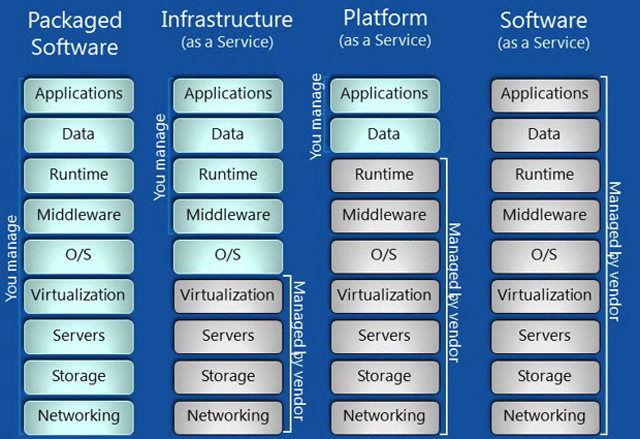Anyone who who follows technology trends has undoubtedly heard the term “cloud service” thrown around a few gazillion times over the past few months. But if you don’t know the difference between terms such as PaaS, IaaS and SaaS, don’t fret — you’re far from alone.
Let’s start at the beginning. “Cloud” is a metaphor for the Internet, and “cloud computing” is using the Internet to access applications, data or services that are stored or running on remote servers.
When you break it down, any company offering an Internet-based approach to computing, storage and development can technically be called a cloud company. However, not all cloud companies are the same. Typically, these companies focus on offering one of three categories of cloud computing services. These different segments are called the “layers” of the cloud.
Not everyone is a CTO or an IT manager, so sometimes following the lingo behind cloud technology can be tough. With our first-annual CloudBeat 2011 conference coming up at the end of this month, we thought this would be a good opportunity to go over the basics of what purpose each layer serves and some company examples to help give each term more meaning.
Layers of the cloud
A cloud computing company is any company that provides its services over the Internet. These services fall into three different categories, or layers. The layers of cloud computing, which sit on top of one another, are Infrastructure-as-a-Service (IaaS), Platform-as-a-Service (PaaS) and Software-as-a-Service (SaaS). Infrastructure sits at the bottom, Platform in the middle and Software on top. Other “soft” layers can be added on top of these layers as well, with elements like cost and security extending the size and flexibility of the cloud.
Here is a chart showing simplified explanations for the three main layers of cloud computing:
IaaS: Infrastructure-as-a-Service
The first major layer is Infrastructure-as-a-Service, or IaaS. (Sometimes it’s called Hardware-as-a-Service.) Several years back, if you wanted to run business applications in your office and control your company website, you would buy servers and other pricy hardware in order to control local applications and make your business run smoothly.
But now, with IaaS, you can outsource your hardware needs to someone else. IaaS companies provide off-site server, storage, and networking hardware, which you rent and access over the Internet. Freed from maintenance costs and wasted office space, companies can run their applications on this hardware and access it anytime.
Some of the biggest names in IaaS include Amazon, Microsoft, VMWare, Rackspace and Red Hat. While these companies have different specialties — some, like Amazon and Microsoft, want to offer you more than just IaaS — they are connected by a desire to sell you raw computing power and to host your website.
PaaS: Platform-as-a-Service
The second major layer of the cloud is known as Platform-as-a-Service, or PaaS, which is sometimes called middleware. The underlying idea of this category is that all of your company’s development can happen at this layer, saving you time and resources.
PaaS companies offer up a wide variety of solutions for developing and deploying applications over the Internet, such as virtualized servers and operating systems. This saves you money on hardware and also makes collaboration easier for a scattered workforce. Web application management, application design, app hosting, storage, security, and app development collaboration tools all fall into this category.
Some of the biggest PaaS providers today are Google App Engine, Microsoft Azure, Saleforce’s Force.com, the Salesforce-owned Heroku, and Engine Yard. A few recent PaaS startups we’ve written about that look somewhat intriguing include AppFog, Mendix and Standing Cloud.
SaaS: Software-as-a-Service
The third and final layer of the cloud is Software-as-a-Service, or SaaS. This layer is the one you’re most likely to interact with in your everyday life, and it is almost always accessible through a web browser. Any application hosted on a remote server that can be accessed over the Internet is considered a SaaS.
Services that you consume completely from the web like Netflix, MOG, Google Apps, Box.net, Dropbox and Apple’s new iCloud fall into this category. Regardless if these web services are used for business, pleasure or both, they’re all technically part of the cloud.
Some common SaaS applications used for business include Citrix’s GoToMeeting, Cisco’s WebEx, Salesforce’s CRM, ADP, Workday and SuccessFactors.
We hope you’ll join us at CloudBeat 2011 at the end of the month to explore a number of exciting case studies in cloud services.
Cloud photo via Jeff Coleman/Flickr
Cloud breakdown slide via “Windows Azure Platform: Cloud Development Jump Start” via Microsoft
CloudBeat 2011 takes place Nov 30 – Dec 1 at the Hotel Sofitel in Redwood City, CA. Unlike other cloud events, we’ll be focusing on 12 case studies where we’ll dissect the most disruptive instances of enterprise adoption of the cloud. Speakers include: Aaron Levie, Co-Founder & CEO of Box.net; Amit Singh VP of Enterprise at Google; Adrian Cockcroft, Director of Cloud Architecture at Netflix; Byron Sebastian, Senior VP of Platforms at Salesforce; Lew Tucker, VP & CTO of Cloud Computing at Cisco, and many more. Join 500 executives for two days packed with actionable lessons and networking opportunities as we define the key processes and architectures that companies must put in place in order to survive and prosper. Register here. Spaces are very limited!



